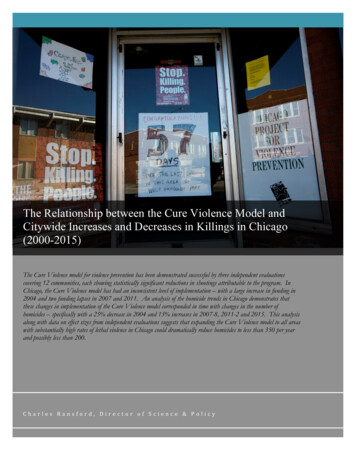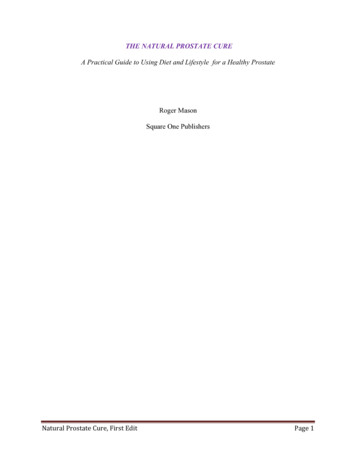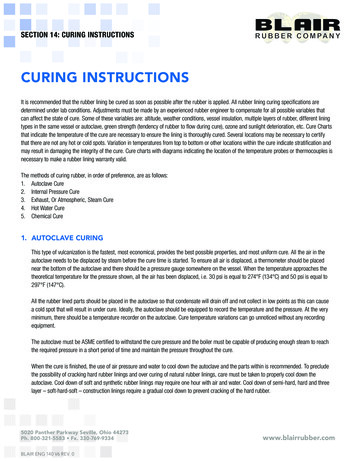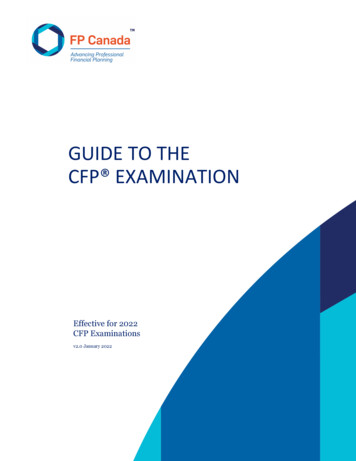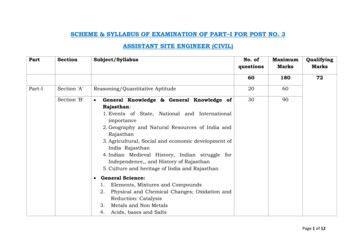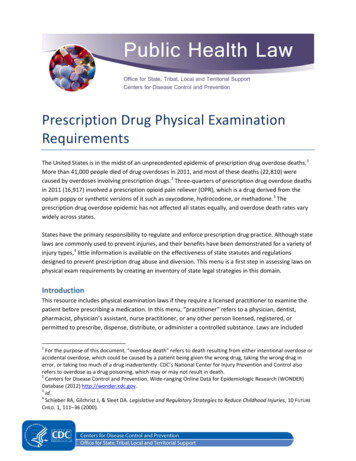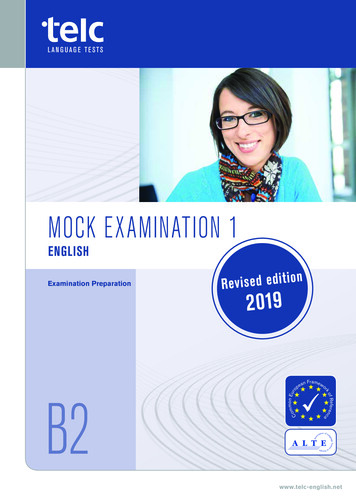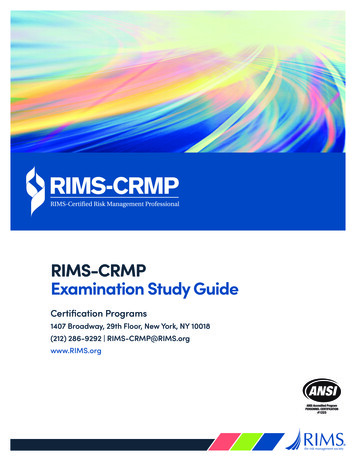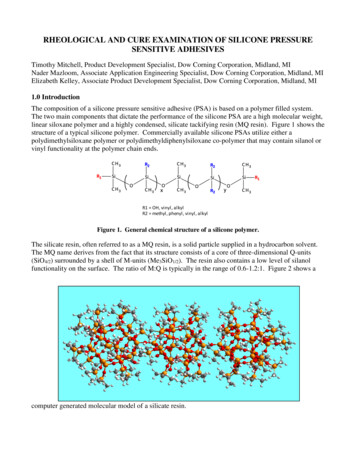
Transcription
RHEOLOGICAL AND CURE EXAMINATION OF SILICONE PRESSURESENSITIVE ADHESIVESTimothy Mitchell, Product Development Specialist, Dow Corning Corporation, Midland, MINader Mazloom, Associate Application Engineering Specialist, Dow Corning Corporation, Midland, MIElizabeth Kelley, Associate Product Development Specialist, Dow Corning Corporation, Midland, MI1.0 IntroductionThe composition of a silicone pressure sensitive adhesive (PSA) is based on a polymer filled system.The two main components that dictate the performance of the silicone PSA are a high molecular weight,linear siloxane polymer and a highly condensed, silicate tackifying resin (MQ resin). Figure 1 shows thestructure of a typical silicone polymer. Commercially available silicone PSAs utilize either apolydimethylsiloxane polymer or polydimethyldiphenylsiloxane co-polymer that may contain silanol orvinyl functionality at the polymer chain ends.R1 OH, vinyl, alkylR2 methyl, phenyl, vinyl, alkylFigure 1. General chemical structure of a silicone polymer.The silicate resin, often referred to as a MQ resin, is a solid particle supplied in a hydrocarbon solvent.The MQ name derives from the fact that its structure consists of a core of three-dimensional Q-units(SiO4/2) surrounded by a shell of M-units (Me3SiO1/2). The resin also contains a low level of silanolfunctionality on the surface. The ratio of M:Q is typically in the range of 0.6-1.2:1. Figure 2 shows acomputer generated molecular model of a silicate resin.
Figure 2. Molecular model of a MQ resin.Silicone PSAs are produced by blending a specified ratio of a MQ resin and siloxane polymer togetherin a hydrocarbon solvent. Heating the mixture to promote a condensation reaction between the availablesilanol functionality on the resin and polymer can further enhance the initial cohesive strength of theadhesive. The ratio of resin to polymer is the most important formulation detail when trying to optimizethe balance of performance properties for a given adhesive. Figure 3 shows an example of how thebalance of resin and polymer can affect the tack, peel adhesion, and shear performance for a siliconePSA. The exact positioning of these curves with respect to the x and y axes and each other isdetermined primarily by the resin composition.Figure 3. The effect of composition on silicone PSA properties.1.1 Adhesive Cure ChemistryAlthough most silicone PSAs will exhibit pressure sensitive behavior immediately after solvent removal,further crosslinking is done to reinforce the adhesive network. The level of additional crosslinking willdepend on the intended application needs of the PSA construction. There are two basic cure systemsavailable for silicone PSAs: peroxide catalyzed free-radical cure and platinum catalyzed silicon hydrideto vinyl addition cure. The majority of commercial silicone PSAs employ the use of a peroxidecatalyzed free-radical reaction to achieve additional crosslink density. Curing of these types ofadhesives is done in multi-zoned ovens due to the use of non-specific peroxides. Solvent removal is firstrequired at lower temperatures (60 to 90 C) to ensure the peroxide does not inadvertently cure solvent inthe PSA matrix which would result in reduced performance and poor temperature stability. At elevatedtemperatures (130 to 200 C), the catalyst decomposes to form free radicals which primarily attack the
organic substituents along the polymer chains to extract protons and generate free radicals1. The freeradicals then combine to form crosslinks as shown by the general reaction mechanism in Figure 4.2Figure 4. General steps in the peroxide catalyzed crosslinking of silicone PSAs.The main benefit of the peroxide catalyzed system is the ability to control properties by addition level ofperoxide used. The tape producer has the flexibility to use a range from 0 to 4 wt% peroxide. Theadditional curing with the peroxide results in a more tightly crosslinked PSA. An increase in cohesivestrength, as evidenced by performance in shear tests, is generally observed. The increase in cohesivestrength is accompanied by a slight decrease in adhesion and tack. Some of the disadvantages of thistype of silicone PSA system include the handling of volatile solvents, generation of peroxide byproducts, more sophisticated curing ovens, and the need for priming of certain substrates to improveadhesive anchorage in the construction of self-wound tapes.As an alternative to the peroxide catalyzed system, silicone PSAs can utilize a platinum catalyzedaddition cure in which a silicon hydride reacts with a silicon vinyl to form a crosslink site. Thischemistry is analogous to the typical solvent-based and solventless platinum catalyzed silicone releasecoating systems used for release liners of organic PSAs. The curing of this type of silicone PSA can beaccomplished in a single-zone oven at lower overall temperatures (100 to 150 C) even though thesesystems are supplied in hydrocarbon solvents. As the solvent evaporates, the platinum catalyzedreaction occurs without any generation of by-products as shown in Figure 5.The ability of the system to be cured at a single, lower temperature offers benefits that are not seen witha peroxide catalyzed system. These benefits include faster line speeds (or cure time), lower sensitivityto temperature variation, the ability to use substrates with lower thermal stability (polyethylene,polypropylene, etc.) and no generation of volatile by-products. Another benefit of the platinumcatalyzed silicone system is the fact that it does not inherently need the hydrocarbon solvent for anythingother than viscosity control. The peroxide catalyzed system not only needs the solvent for viscositycontrol, the solvent keeps the peroxide dissolved within the adhesive bath prior to coating on the web.This advantage of the platinum catalyzed system allows for the ability to manufacture solventlessplatinum catalyzed silicone PSAs.
Pt-1Figure 5. General reaction mechanism in the platinum catalyzed crosslinking of silicone PSAs.2.0 Basic Physical PropertiesThree different types of silicone PSAs were evaluated in this study. A polydimethylsiloxane peroxidecure PSA (Dimethyl Peroxide), a polydimethyldiphenylsiloxane peroxide cure PSA (DiphenylPeroxide), and a polydimethylsiloxane platinum cure PSA (Dimethyl Platinum). The Dimethyl PeroxidePSA would be considered a general purpose silicone PSA with good releasability for label and transferadhesive applications. The Diphenyl Peroxide PSA would be considered for applications that requireperformance in extremely high temperature applications. The Dimethyl Platinum PSA is designed tohave low adhesion properties for applications such as protective films. The non-volatile content (NVC)and viscosity for each material prior to catalyzing and coating is listed in Table 1.Table 1. Basic physical properties of the silicone PSAs.PSA typeNVC (%) Viscosity (cP)Dimethyl Peroxide 56.9126,200Diphenyl Peroxide 55.7339,700Dimethyl Platinum 40.9131,000
3.0 Cured Adhesive Characterization3.1 Formulating, Laminate Preparation, and PSA Testing ProceduresThe peroxide catalyzed materials were formulated by adding a solvent solution of benzoyl peroxide(BPO) in an amount to yield 0, 1, 2, or 4 wt% BPO per silicone solids. Each formulation wassubsequently diluted with additional solvent to reach a final solids content of 50 wt%. The platinumcatalyzed materials were formulated by adding a platinum catalyst and a silicone-hydride (SiH)crosslinker to the vinyl-functional PSA in an amount to yield 0.5, 1.0, or 1.5 wt%.PSA laminates were prepared by coating the formulated adhesives onto 2-mil untreated polyester (PET),2-mil fluorosilicone treated PET, 10-mil untreated PET, and 1-mil untreated polyimide (PI) films using avacuum coating table with an appropriate application bar to target a 1.5-mil dry adhesive thickness. ThePET films coated with the peroxide catalyzed formulations were placed in an air-circulating oven at80 C for two minutes to remove the solvent followed by 180 C for 2 minutes to cure. The second curezone was increased to 204 C when PI films were coated. The platinum catalyzed formulations werecured at 150 C for 3 minutes on all film types. Each prepared laminate was cut into test strips using a1” specimen tape cutter and the thickness was measured using a digital micrometer.The 2-mil untreated PET laminates were characterized by 180 peel adhesion per PSTC-101 and probetack per ASTM D-2979. The 2-mil fluorosilicone treated PET laminates were characterized by peelrelease and rheometry. Prior to testing for release from the fluorosilicone liner, a 2-mil untreated PETfilm was laminated to the PSA to serve as a facestock. The rheology samples were further prepared bystacking several laminates together until a target thickness of 1.5 mm was reached. The fluorosiliconeliner remained on both sides of the rheology sample. The 1-mil untreated PI laminates werecharacterized by high temperature static shear. The 10-mil untreated PET laminates were characterizedby Texture Analyzer.3.2 Dimethyl Peroxide PSASamples of a Dimethyl Peroxide PSA were prepared at levels of BPO catalyst varying from 0 to 4 wt%to evaluate the impact that the extent of cure would have on the resulting performance properties. Thelaminate thickness, peel adhesion, and tack results on 2-mil PET are shown in Table 2.Table 2. Laminate thickness, peel adhesion, and tack results for the Dimethyl Peroxide PSA.BPO (%) Avg Thickness (mil) Adhesion (g/in) Tack 341.651101.0577.0As the level of catalyst was increased for the Dimethyl Peroxide PSA, it was found that there was adecreasing trend in both the adhesion and tack performance. This indicates that increasing the crosslinkdensity of the Dimethyl Peroxide PSA has a direct, inverse relationship to these performance properties.Release from the 2-mil fluorosilicone treated PET liner (or fluorosilicone release liner) was tested at 1,7, and 14 days of room temperature (RT) aging. The release testing was completed using a delamination
rate of 12 inches per minute while removing the liner at an angle of 180 from the laminate. The resultsare shown in Figure 6.Dimethyl Peroxide PSA - Release Force1 day RT6007 day RT14 day RT553500Release Force (g/in)40035330020015710058362133440481800124BPO (%)Figure 6. Release testing of the Dimethyl Peroxide PSA from a fluorosilicone release liner.The release force increased as the level of peroxide increased for the Dimethyl Peroxide PSA. Therewas a significant increase in release force when moving from 2 to 4 wt% peroxide. Within each set ofcured material (0, 1, 2, and 4 wt% BPO), the release force peaked at 7 days of aging. Although theincreasing release force appears to have a direct relationship to the catalyst loading, the increase incrosslink density may not entirely account for the performance exhibited. Each formulation was coateddirectly onto the fluorosilicone release liner prior to cure. This has the potential to allow the peroxidecatalyst to interact with the liner during the cure cycle and likely contributes to part of the increasingrelease forces.The high temperature static shear performance was tested at 300 C using a 1 kilogram weight. Thelaminates were tested until complete failure was reached. The results are shown in Table 3.Table 3. High temperature static shear results for the Dimethyl Peroxide PSA.BPO (%) Fail Time Failure Mode015 minCohesive130 minCohesive230 minCohesive49 DayCohesive
As the level of catalyst was increased for the Dimethyl Peroxide PSA, the static shear performanceexhibited an increasing trend. This indicates that increasing the crosslink density of the DimethylPeroxide PSA has a direct relationship to increasing static shear performance.The stress-strain curves generated by the TA-XT2i Texture Analyzer2 can be used as a supplement toevaluate the performance of the PSA. Studies have shown that the failure energy, as calculated byintegration of the area under the curve, relates to the behavior of the adhesive during the bonding anddebonding process3, 4, 5. The calculations on each curve include the peak force, total area under thecurve, and the area ratio (area post-peak / area pre-peak). Each 10-mil PET laminate was tested on theTexture Analyzer using a 7mm, stainless steel punch probe with a 1” radius at a test speed of 0.2mm/sec, dwell time of 0.5 seconds, and test force of 100 grams. The results are shown in Figure 7 andTable 4.Dimethyl Peroxide PSA - Texture Analyzer with Various Peroxide Levels0%1%2%4%12010080Force (seconds)6040200-20-40-60-80012345Time (seconds)Figure 7. Texture Analyzer results for the Dimethyl Peroxide PSA.Table 4. Texture Analyzer results for the Dimethyl Peroxide PSA.6
BPO (%)0124Average PeakForce (g)93.2392.59102.47103.03Average TotalArea (g.s)90.5782.1877.6457.25Average AreaRatio3.913.462.451.60As can be seen in the TA curves, there is a secondary shoulder generated during the debonding stepwhich indicates that fibrils are forming for these PSAs. The secondary shoulder and subsequent distanceto probe separation decreases as the level of catalyst increases. The decrease in Total Area and AreaRatio correlates well with the adhesion and tack testing results for the Dimethyl Peroxide PSA.Understanding the viscoelastic nature of silicone PSAs can help guide the proper selection of PSA type(dimethyl, diphenyl, etc.), crosslink density, and additives for a particular application. In addition, therheological profile of a system can be used as a troubleshooting tool for determining sources ofperformance failures, as well as correlating against other performance tests. The rheology of eachformulation was conducted using a dynamic temperature ramp at a rate of 2 C per minute. Each samplewas tested using 8 mm stainless steel parallel plates at a frequency of 10 radians per second and aconstant strain of 0.1%. The results are shown in Figure 8 and Table 5.Figure 8. G’ and tan delta curves for the temperature ramp testing of the Dimethyl Peroxide PSA.
Table 5. Selected rheology values for the Dimethyl Peroxide PSA.BPO (%)0124Tg ( C)45.143.241.641.1Tan Delta at Tg1.191.101.040.90The impact of crosslink density through catalyst addition for the Dimethyl Peroxide PSA becomesevident by the rheology analysis. As the catalyst concentration increases, the position of the Tg and themagnitude of the tan delta peak decreases. The largest effect is found in the rubbery plateau regionswhere the higher crosslink density increases the storage modulus. This reduces the ability of the PSA todissipate energy and results in lower peel adhesion and tack. The tan delta profile at temperatures greaterthan roughly 115 C demonstrate how lower crosslinked systems start to exhibit flow when compared tothe same PSA at higher catalyst levels.3.3 Diphenyl Peroxide PSASamples of a Diphenyl Peroxide PSA were prepared at levels of BPO catalyst varying from 0 to 4 wt%to evaluate the impact that the extent of cure would have on the resulting performance properties. Thelaminate thickness, peel adhesion, and tack results on 2-mil PET are shown in Table 6.Table 6. Laminate thickness, peel adhesion, and tack results for the Diphenyl Peroxide PSA.BPO (%) Avg Thickness (mil) Adhesion (g/in) Tack 2.141.621104.5719.0As the level of catalyst was increased for the Diphenyl Peroxide PSA, it was found that there was adecreasing trend in both the adhesion and tack performance. The adhesion did reached a maximumperformance level at 2 wt% peroxide before decreasing back to the lowest level at 4 wt% BPO.Release of the Diphenyl Peroxide PSA from the fluorosilicone release liner was tested at 1, 7, and 14days of room temperature (RT) aging. The release testing was completed using a delamination rate of12 inches per minute while removing the liner at an angle of 180 from the laminate. The results areshown in Figure 9.
Diphenyl Peroxide PSA - Release Force1 day RT7 day RT14 day RT400383337307Release Force (g/in)30019920018414410084905517181500124BPO (%)Figure 9. Release testing of the Diphenyl Peroxide PSA from a fluorosilicone release liner.The release force increased as the level of peroxide increased for the Diphenyl Peroxide PSA. Thisbehavior is similar to that seen with the Dimethyl Peroxide PSA. Within each set of cured material (0,1, 2, and 4 wt% BPO), the release force continued to increase as the laminates aged.The high temperature static shear performance for the Diphenyl Peroxide PSA is shown in Table 7.Table 7. High temperature static shear results for the Diphenyl Peroxide PSA.BPO (%)0124Fail TimeFailure Mode15 minCohesive30 minCohesive1 hourCohesiveEnded after 9 DaysNAAs the level of catalyst was increased for the Diphenyl Peroxide PSA, the static shear performanceexhibited an increasing trend. This indicates that increasing the crosslink density of the DiphenylPeroxide PSA has a direct relationship to the increase in static shear performance. At 4 wt% BPO, thetesting was discontinued after the sample did not exhibit slip even after 9 days.Each 10-mil PET laminate coated with the Diphenyl Peroxide PSA was tested on the Texture Analyzerand the results are shown in Figure 10 and Table 8.
Diphenyl Peroxide PSA - Texture Analyzer at Various Peroxide Levels0%1%2%4%1201008060Force (grams)40200-20-40-60-800123456Time (seconds)Figure 10. Texture Analyzer results for the Diphenyl Peroxide PSA.Table 8. Texture Analyzer results for the Diphenyl Peroxide PSA.BPO (%)0124Average PeakForce (g)76.1978.7485.794.21Average TotalArea (g.s)91.9691.4488.2768.97Average AreaRatio5.915.544.332.52As can be seen in the TA curves, there is a secondary shoulder for each sample which indicates thatthese PSAs are forming fibrils during the debonding step. The secondary shoulder was much larger forthe Diphenyl Peroxide PSA than the Dimethyl Peroxide PSA. This correlates to a tackier PSA at roomtemperature. The secondary shoulder and subsequent distance to probe separation decreases as the levelof catalyst increases. The decrease in Total Area and Area Ratio correlates well with the adhesion andtack testing results.The rheology of each Diphenyl Peroxide PSA formulation was conducted using a dynamic temperatureramp at a rate of 2 C per minute. Each sample was tested using 8 mm stainless steel parallel plates at afrequency of 10 radians per second and a constant strain of 0.1%. The results are shown in Figure 11and Table 9.
Figure 11. G’ and tan delta curves for the temperature ramp testing of the Diphenyl Peroxide PSA.Table 9. Selected rheology values for the Diphenyl Peroxide PSA.BPO %0124Tg ( C)11.912.712.612.4Tan Delta at Tg1.361.271.211.07The Diphenyl Peroxide PSA in this example has better high temperature stability when compared to theDimethyl Peroxide PSA at the same peroxide loading. In the rheology analysis, this is indicated by thetan delta plateau and flatter G’. The Tg and magnitude of tan delta is greater for the Diphenyl PSA at alllevels of peroxide concentration. As the catalyst concentration increases, the position of the Tg and themagnitude of the tan delta peak decreases. The largest effect is found in the rubbery plateau regionswhere the higher crosslink density increases the storage modulus. The higher crosslink increases thestorage modulus. The tan delta profile at temperatures greater than roughly 85 C demonstrate howlower crosslinked systems start to exhibit flow when compared to the same PSA at higher catalystlevels.3.4 Dimethyl Platinum PSASamples of a Dimethyl Platinum PSA were prepared at levels of crosslinker varying from 0.5 to 1.5 wt%to evaluate the impact that extent of cure would have on the resulting performance properties. A sampleat 0% crosslinker was attempted but incomplete cure led to cohesive failure. The laminate thickness,peel adhesion, and tack results on 2-mil PET are shown in Table 10.
Table 10. Laminate thickness, peel adhesion, and tack results for the Dimethyl Platinum PSA.XL (%)0.51.01.5Avg Thickness (mil) Adhesion (g/in) Tack (g)1.674.152.81.693.241.71.673.147.3The unique nature of this “low adhesion” PSA results in minimal adhesion and tack properties whentested against stainless steel substrates. As the level of crosslinker was increased for the DimethylPlatinum PSA, it was found that there was a decreasing trend in the adhesion and tack performance.Release of the Dimethyl Platinum PSA from the fluorosilicone release liner was tested at 1, 7, and 14days of room temperature (RT) aging. The release testing was completed using a delamination rate of12 inches per minute while removing the liner at an angle of 180 from the laminate. The results areshown in Figure 12.Dimethyl Platinum PSA - Release Force1 day RT7 day RT14 day RT5.04.524.404.384.193.914.03.753.45Release Force (g/in)3.253.253.02.01.00.00.51.0Crosslinker (%)1.5Figure 12. Release testing of the Dimethyl Platinum PSA from a fluorosilicone release liner.A minimum release force for the Dimethyl Platinum PSA is seen at 1.0 wt% crosslinker. Samplesprepared at 0.5 and 1.5 wt% crosslinker show a decreasing trend with time. The 1.0 wt% crosslinkersample was stable over the 14 day test period.The high temperature static shear performance for the Dimethyl Platinum PSA is shown in Table 11.
Table 11. High temperature static shear results for the Dimethyl Platinum PSA.XL (%)0.51.01.5Fail Time45 min6 DayEnded after 14 DaysFailure ModeCohesiveCohesiveNAAs the level of crosslinker was increased for the Diphenyl Platinum PSA, the static shear performanceshowed significant improvement. In fact, the performance of the Dimethyl Platinum PSA was the bestof the 3 PSAs evaluated in this study.Each 10-mil PET laminate coated with the Dimethyl Platinum PSA was tested on the Texture Analyzerand the results are shown in Figure 13 and Table 12.Dimethyl Platinum PSA - Texture Analyzer at Various Crosslinker Levels0.5%1.0%1.5%1201008060Force (grams)40200-20-40-60-80012345Time (seconds)Figure 13. Texture Analyzer results for the Dimethyl Platinum PSA.Table 12. Texture Analyzer results for the Dimethyl Platinum PSA.XL (%)0.51.01.5Average PeakForce (g)17.5822.4824.48Average TotalArea (g.s)1.201.832.10Average AreaRatio0.620.480.466
The Texture Analyzer testing of the Dimethyl Platinum PSA showed very small peaks indicating lowtack and adhesion performance. The results showed very little differentiation between levels ofcrosslinker.The Dimethyl Platinum PSA used in this study presented additional challenges when attempting to testrheology owing to the low adhesion nature of the cured material. At low temperatures, the PSA wouldnot remain in contact with the parallel plates and resulted in poor data. The sample was submitted forDMA analysis using testing conditions similar to those used for silicone elastomers. Film tensionclamps were used to secure the cured material and a multi rate temperature ramp was utilized. Between-145 C and -30 C the rate was 0.5 C/min, and at temperatures above -30 C it increased to 3.0 C/min. A strain rate of 0.25% was applied at 10 radians per second. The results are shown in Figure14 and Table 13.Figure 14. E’ and tan delta curves for the temperature ramp testing of the Dimethyl Platinum PSA.Table 13. Selected rheology values for the Dimethyl Platinum PSA.XL (%)0.51.01.5Tg ( C)-121-122-120Tan Delta at Tg0.8540.8490.829As opposed to the peroxide cured systems, the Dimethyl Platinum PSA does not show appreciablevariation when changing crosslinker levels. The vinyl functionality available on the polymer portion ofthe PSA is limited and therefore adding the additional SiH containing crosslinker did change the elasticmodulus significantly above -25 C.
4.0 SummaryIncreasing crosslink density through peroxide addition provides a silicone PSA with higher temperaturestability for applications such as heat seal and plating tapes. Applications that would require more tackand adhesion from the same PSA, such as splicing tape, may benefit from a lower peroxide loading.Decreasing the amount of peroxide also has the effect of lowering the storage modulus of the PSAallowing for more flow and subsequent wetting of the PSA on low energy substrates. PSAs which utilizea dimethyldiphenylsiloxane co-polymer can tolerate higher temperatures when compared to traditionaldimethylsiloxane based materials. The performance benefits would lend themselves to applications suchas plasma, high velocity oxygen fuel (HVOF), and other high temperature masking tapes.Whereas the crosslink density of the peroxide catalyzed PSAs can be modified through incrementalcatalyst addition, the platinum catalyzed PSAs are more limited due to the dependence on theavailability of vinyl and hydride functionality on the polymers used in the formulation. The lowadhesion and tack performance of these PSAs make them ideal for use in applications such as electronicdevice protective films where fast wetting along with low and stable adhesion are desired.As demonstrated in this study, the rheology and performance of a peroxide catalyzed PSA can bemodified by the extent of crosslinking introduced by variations in the catalyst levels. Alternatively, therheological profiles of a PSA can be more aggressively targeted to meet the needs of a specificapplication through the use of PSA additives.Figure 15. The rheological impact of adding a modifier to the Diphenyl Peroxide PSA.
Figure 15 shows an example of a Diphenyl PSA before and after the addition of a modifier. The effectof the addition is the concurrent increase in the glass transition temperature and the tan delta peak. Thehigher tan delta peak is an indicator of the energy dissipation potential of the system that could be usedto tune vibration dampening.Understanding the relationships between crosslink density, adhesion, tack, release, and rheology to theend application will give the technologist the tools to make better material selection when designing aPSA construction.5.0 Literature Citations1. Sobieski, L. A. and Tangney, T. J. Silicone Pressure Sensitive Adhesives. Handbook ofPressure Sensitive Adhesive Technology, (D. Satas, ed.). 2nd Edition, Van Nostrand Reinhold,New York, 1989, 508-517.2. Stable Micro Systems, Godalming, Surrey, U.K.3. Zosel, A.; The effect of bond formation on the tack of polymers. Journal of Adhesion Scienceand Technology, 11(11):1447-1457, 1997.4. Zosel, A.; The effect of fibrillation on the tack of pressure sensitive adhesives. InternationalJournal of Adhesion & Adhesives, 18(4):265-272, 1998.5. Zosel, A.; Molecular Structure, Mechanical Behaviour and Adhesion Performance of PressureSensitive Adhesives. Technical Seminar Proceedings, Pressure Sensitive Tape Council,Northbrook, Ill., May 3-5, 2000.6.0 AcknowledgmentsThe authors would like to acknowledge Dave Dingman and Lacey Brissette for their help preparing andtesting adhesives, as well as Myoungbae Lee for the DMA analysis.
RHEOLOGICAL AND CURE EXAMINATION OF SILICONE PRESSURE SENSITIVE ADHESIVES . inverse relationship to these performance properties. Release from the 2-mil fluorosilicone treated PET liner (or fluorosilicone release liner) was tested at 1, 7, and 14 days of room temperature (RT) agin

